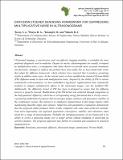| dc.description.abstract | Ultrasound imaging, a non-invasive and cost-effective imaging modality, is probably the most preferred diagnostic tool in medicine. Despite its merits, ultrasonograms are usually corrupted by multiplicative noise, a consequence that limits doctors to provide more accurate treatments and decisions. Attempts to address the problem have been made, but we have found little works that adopt the diffusion framework, which scholars have reported that it produces promising results in additive noise cases. In the current work, we have modified the classical Perona-Malik (PM) diffusion model to deal with multiplicative noise. Inspired by the ability of PM to restore semantically critical features, we have embedded a log-based regularization term, statistically modeled to mitigate multiplicative effects in the ultrasound images, into the modified PM. Additionally, the diffusivity kernel of PM has been re-designed to ensure that the diffusion process is properly steered. Modification of the PM kernel was achieved through integration of the half-quadratic diffusivity, which has a corresponding energy functional that is strictly convex, a promising mathematical property that encourages unique solutions and guarantees stability of the evolutionary system. Our interest is to emphasize regularization in flat image regions while maintaining plausible edges and contours. Subjective and quantitative evaluations demonstrate that the proposed model produces better results compared with some state-of-the-art methods. Even more importantly, our approach guarantees convergence, stability, and robustness when tested for a range of ultrasonograms. Probably the intriguing property of our framework is its ability to evolve a denoising image over a longer period without smudging or destroying its sensitive features. The proposed approach may further be extended and actualized in practical imaging devices. | en_US |

